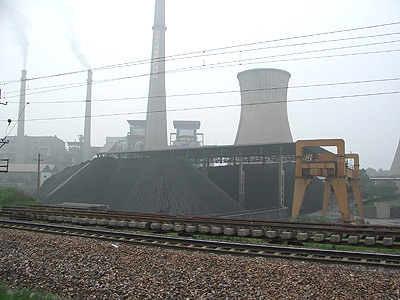Berkeleyan
 |
When responsibility for building new power plants in China shifted from central administrators to local-government officials, many of the latter authorized the construction of dirty, '50s-style plants built to archaic Soviet specs. |
Alarming increase in growth of China's CO2 emissions anticipated
Now the top emitter of carbon dioxide worldwide, China is especially culpable, researchers say, for its tolerance of provincial pollution during its rush to development
![]()
| 12 March 2008
The growth in China's carbon dioxide (CO2) emissions is far outpacing previous estimates, making the goal of stabilizing atmospheric greenhouse gases even more difficult, according to a new analysis by economists at Berkeley and UC San Diego.
Previous estimates, including those used by the Intergovernmental Panel on Climate Change, say the region that includes China will see a 2.5- to 5-percent annual increase in CO2 emissions, the largest contributor to atmospheric greenhouse gases, between 2004 and 2010. The new UC analysis puts that annual growth rate for China at at least 11 percent for the same time period.
The study is scheduled for print publication in the May issue of the Journal of Environmental Economics and Management but is now online.
The researchers' most conservative forecast predicts that, by 2010, there will be an increase of 600 million metric tons of carbon emissions in China over the country's levels in 2000. This growth from China alone would dramatically overshadow the 116 million metric tons of carbon-emissions reductions pledged by all the developed countries in the Kyoto Protocol. (The protocol was never ratified in the United States, which was the largest single emitter of carbon dioxide until 2006, when China took over that distinction, according to numerous reports.)
Put another way, the projected annual increase in China alone over the next several years is greater than the current emissions produced by either Great Britain or Germany.
Based upon these findings, the authors say current global-warming forecasts are "overly optimistic" and that action is urgently needed to curb greenhouse-gas production in China and other rapidly industrializing countries.
The authors of the study, Maximillian Auffhammer, an assistant professor of agricultural and resource economics at Berkeley, and Richard Carson, UC San Diego professor of economics, based their findings upon pollution data from China's 30 provincial entities.
Auffhammer says this paper should serve as an alarm challenging the widely held belief that actions taken by the wealthy, industrialized nations alone represent a viable strategy toward the goal of stabilizing atmospheric concentrations of carbon dioxide.
"Making China and other developing countries an integral part of any future climate agreement is now even more important," says Auffhammer. "It had been expected that the efficiency of China's power generation would continue to improve as per-capita income increased, slowing down the rate of CO2 emissions growth. What we're finding instead is that the emissions growth rate is surpassing our worst expectations, and that means the goal of stabilizing atmospheric CO2 is going to be much, much harder to achieve."
Researchers traditionally calculate the CO2 emissions for a region or country from data on fossil fuel consumption. Existing models then use those emission figures and factor in such variables as population size, a society's affluence, and technology developments to forecast the growth of greenhouse-gas emissions.
In explaining the startling differences in results from previous estimates for China's carbon emissions growth, the UC researchers point out that they used province-level figures in their analysis to obtain a more detailed picture of the country's CO2 emissions up to 2004.
Taking provincial differences into account
"Everybody had been treating China as single country, but each of the country's provinces is larger than many European countries, both in geographic size and population," says Carson. "In addition, there is a wide range in economic development and wealth from one province to the next, as well as major differences in population growth, all of which has an effect on energy consumption that cannot be easily addressed in models based upon aggregate national data."
Since data on fossil-fuel consumption are not reported at the province level in China, the researchers used waste-gas emissions, available from China's state environmental-protection administration reports, as a proxy for CO2 emissions in this paper.
Moreover, the researchers say, the majority of other studies forecasting China's CO2 emissions relied upon information from nearly a decade ago. During the 1990s, per capita income was growing faster than the use of energy in China, which typically relates to slower growth in carbon emissions.
"A notable shift occurred in China around the year 2000, around the time when hope for an agreement with the U.S. on the Kyoto Protocol began to diminish along with external pressure for China to reduce its emissions," says Carson. "Energy use started to grow faster than income, and much of the energy that was used wasn't efficient."
No incentive to build green
The authors also point out that after 2000, China's central government began shifting the responsibility for building new power plants to provincial officials who had less incentive and fewer resources to build cleaner, more efficient plants, which save money in the long run but are more expensive to construct.
"Government officials turned away from energy efficiency as an objective to expanding power generation as quickly as they can, and as cheaply as they can," says Carson. "Wealthier coastal provinces tended to build clean-burning power plants based upon the very best technology available, but many of the poorer interior provinces replicated inefficient 1950s Soviet technology."
"The problem is that power plants, once built, are meant to last for 40 to 75 years," says Carson. "These provincial officials have locked themselves into a long-run emissions trajectory that is much higher than people had anticipated. Our forecast incorporates the fact that much of China is now stuck with power plants that are dirty and inefficient."
Research funding for the study came from the University of California's Institute of Global Conflict and Cooperation.

